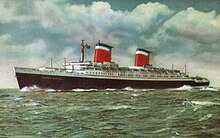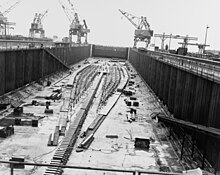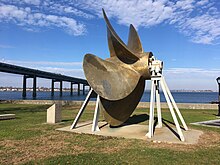SS United States
The ship was designed by American naval architect William Francis Gibbs and could have been converted into a troopship if required by the United States Navy in time of war.
The damage was so severe the former Chief of US Navy Construction and Gibb's mentor David Taylor thought the ship would immediately sink, much like the RMS Empress of Ireland did in similar circumstances.
[7]: 93 To achieve the aesthetic, the liner was furnished with mid-century modern decor that was amplified by plentiful use of black linoleum decking and the silver lining of edges.
To avoid this issue on United States, Gibbs decided the funnels and the superstructure would made out of lightweight aluminum to prevent the ship from becoming top-heavy and at risk of capsizing.
The shipyard, looking for a project to fill the void left by the Navy, agreed to dismantle the aircraft carrier and build an ocean liner with, coincidentally, the same name, in the same dry dock,[27][28] allowing her keel to be laid on 8 February, 1950.
After the Inchon Landings during the Korean War, the Department of Defense realized it lacked troop-transport capacity and requisitioned the one-third-completed United States to quickly and cheaply fill part of the deficit.
Under Navy control, stateroom bathrooms were to be stripped and large spaces divided to make room for gun mounts, wardrooms, more lifeboats, and equipment required to support the enlarged passenger count.
[1] : 227 United States made her maiden voyage from July 3 to 7, 1952, and broke the eastbound-transatlantic speed record that had been held by RMS Queen Mary for the previous 14 years by more than 10 hours, making the crossing from the Ambrose lightship at New York Harbor to Bishop Rock off Cornwall, UK, in three days, ten hours, and 40 minutes at an average speed of 35.59 kn (65.91 km/h; 40.96 mph),[30] winning the coveted Blue Riband.
[32] The ship's return to the United States was marked with celebration as she was escorted into New York City by bands, helicopters, and small boats, and was met by a crowd of thousands.
The centerpiece of the event was the liner's captain, Commodore Harry Manning, who is one of the few people to receive a Ticker-tape parade twice after his 1929 rescue of crewmembers from the cargo ship Florida.
He hoped Cunard Line, which operated Queen Elizabeth, would then develop a slightly faster ship and United States would then break the intentionally low record, sailing at a much higher speed.
[33] During the 1950s and early 1960s, United States was popular for transatlantic travel, sailing between New York, Southampton, and Le Havre, with an occasional additional call at Bremerhaven.
[36] She attracted frequent, repeat, celebrity passengers such as Marilyn Monroe, Judy Garland, Cary Grant, Salvador Dalí, Duke Ellington, and Walt Disney, who featured the ship in the 1962 film Bon Voyage!.
This trend escalated as the advent of jet-propelled airliners provided trans-Atlantic routes that were only hours long, compared to days on the fastest ocean liners.
The new corporate strategy was to develop a major advertising campaign that was aimed at reinventing the allure of ocean liners in the age of jet aircraft by promoting the ship's speed, luxury, reputation, or another aspect of United States.
With no warning, newly unemployed crewmembers had only days to finalize work while passengers' awaiting baggage was loaded onto Leonardo Da Vinci for a new cruise.
[39]: 184–185 At the time of her withdrawal, United States had made 800 transatlantic crossings (400 round trips), steamed 2,772,840 nautical miles (5,135,300 km; 3,190,930 mi), and carried 1,025,691 passengers.
[20] The same year, a group headed by Harry Katz sought to purchase the ship and dock her in Atlantic City, New Jersey, for use as a hotel and casino, but the plan was never realized.
According to the GAO, the United States Maritime Administration (MARAD) attempted to sell or charter the ship to private parties immediately upon taking possession in February, 1973.
[39]: 194–196 In 1980, United States was sold for $7 million to a group headed by the Seattle developer Richard H. Hadley, who hoped to convert the liner into a floating condominium.
[60] On July 30, 2009, H. F. Lenfest, a Philadelphia media entrepreneur and philanthropist, pledged a matching grant of $300,000 to help the Conservancy purchase the vessel from NCL's parent company.
The Conservancy announced donors to the virtual ship would be featured in an interactive "Wall of Honor" aboard the future SS United States museum.
[89] On August 5, 2016, the plan was abandoned; Crystal Cruises cited the project's technical and commercial challenges, and donated $350,000 to help preservation effort until the end of the year.
[95] On December 10, 2018, the Conservancy announced an agreement with the commercial real estate firm RXR Realty to explore options for restoring and redeveloping United States.
[96] The Conservancy required any redevelopment plan to preserve the ship's profile and exterior design, and include approximately 25,000 sq ft (2,323 m2) for an onboard museum.
[99] The 2023 plan document also included several rendered images of the redesigned United States depicting the ship docked along Manhattan's West Side at a public pier in Hudson River Park.
[103][107] On August 30, Florida's Okaloosa County announced its plan to buy United States and sink her as the world's largest artificial reef off Destin-Fort Walton beach at a cost of $1 million.
[118] The Mariners' Museum of Newport News holds many objects from United States, including Expressions of Freedom by Gwen Lux, a main-dining-room sculpture it purchased during the 1984 auction.
[47] Celebrity Cruises purchased artworks designed by Charles Gilbert, including glass panels etched with sea creatures from the first-class ballroom, and incorporated them into the United States-themed restaurant aboard Infinity .
[125] A large collection of dining-room furniture and other memorabilia from United States that had been purchased at the 1984 auction was incorporated at Windmill Point Restaurant in Nags Head, North Carolina.














